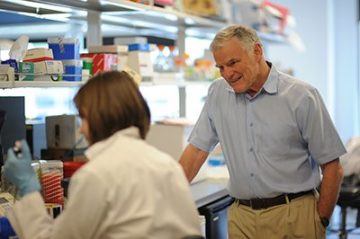Albert and Mary Lasker Foundation Newsletter:
 The highlights of Leroy Hood’s scientific career are like peaks in a mountain range spanning diverse fields, from molecular immunology and engineering, to genomics, to systems medicine. But Hood doesn’t think his trailblazing approach should be unusual, emphasizing that “one of the really key things about science is every 10 or 15 years, you really make a dramatic break and do something new… and you have to learn a lot before you can make fundamental contributions.”
The highlights of Leroy Hood’s scientific career are like peaks in a mountain range spanning diverse fields, from molecular immunology and engineering, to genomics, to systems medicine. But Hood doesn’t think his trailblazing approach should be unusual, emphasizing that “one of the really key things about science is every 10 or 15 years, you really make a dramatic break and do something new… and you have to learn a lot before you can make fundamental contributions.”
One of Hood’s early contributions was in cracking the long-standing mystery of how the immune systems of humans and all vertebrates give rise to the vast diversity of antibodies that is critical for fighting myriad pathogens and foreign substances. During his PhD research at the California Institute of Technology (Caltech) in the mid-1960s, Hood and his advisor, William Dreyer, determined the amino acid sequences of components of antibody molecules and found that their sequences varied greatly between different antibodies. The finding helped advance their idea that each antibody is actually encoded by more than one gene, a big challenge to the existing dogma. Later, with his own research group at Caltech, Hood detailed the intricate process of how segments of antibody-encoding genes are rearranged, further creating antibody diversity. For his work in this area, Hood, along with Philip Leder and Susumu Tonegawa, won the Albert Lasker Basic Medical Research Award in 1987.
Despite his groundbreaking discoveries in molecular immunology, Hood has not focused on this field for the last 20 years or so. Soon after starting his research group in 1970, he realized there were “striking technological limitations” that were holding scientists back from deeper understanding of the immune system. So, over the next two decades, Hood and his colleagues set out developing instruments, including the first automated DNA sequencer that allowed more rapid reads of genes. Hood’s intense focus on technology development as a faculty member at Caltech opened his eyes to what was the first paradigm shift of his career: “bringing engineering to biology.”
More here.
